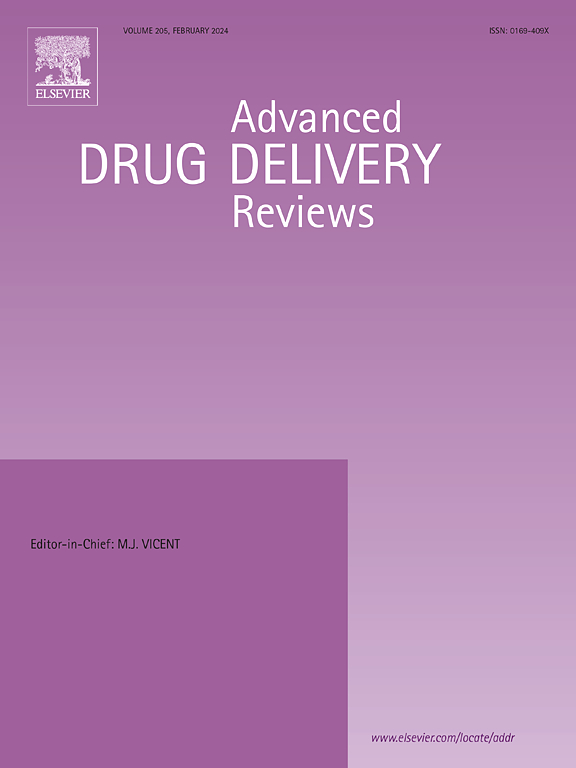Sonodynamic therapy: transforming sound into light for hard-to-treat tumours
IF 17.6
1区 医学
Q1 PHARMACOLOGY & PHARMACY
引用次数: 0
Abstract
Sonodynamic therapy (SDT) is an emerging therapeutic modality against hard-to-treat tumours. It involves the use of ultrasound (US) to excite sono-sensitive moieties to produce reactive oxygen species (ROS), which induce tumour cell death. SDT employs the synergetic application of enabling chemicals named sonosensitizers and low-intensity ultrasound. Compared with photodynamic therapy, SDT has the significant advantages of deeper tissue penetration, higher accuracy, and potentially fewer adverse effects if well-designed. There are multiple suggested mechanisms for activating sonosensitizers for SDT, including sonoluminescence, pyrolysis and direct mechanical activation. However, a highly reported mechanism of action and the focus for this review is sonoluminescence (SL). SL is defined as the light generated by catastrophic implosions of oscillating bubbles in a liquid under exposure to ultrasound (US). SL has been shown to interact with sensitising molecules similar to photodynamic therapy to generate ROS. This mechanism involves delocalisation of the excited electron and subsequent transfer from excited sonosensitizers to nearby oxygen molecules (H2O and O2) in the surrounding tissues to produce ROS such as superoxides, peroxides, singlet oxygen and hydroxyl radicals. In SDT, both SL and sonosensitizers play a role in generating enough ROS to initiate the observed anticancer effects. These effects have been investigated in in vitro, in vivo and recently applied in clinical settings. There are several questions pertaining to the efficiency and safety of SDT and sonosensitizers for anticancer treatment, especially in hard-to-treat tumours, which are discussed here. Although the application of SDT has rapidly reached the clinical phase, fundamental studies are still needed to address and understand the complex mechanisms involved in the anticancer effect of SDT.


声动力疗法:将声音转化为光来治疗难以治疗的肿瘤
声动力疗法(SDT)是一种针对难以治疗的肿瘤的新兴治疗方式。它涉及使用超声(US)来激发声敏感部分产生活性氧(ROS),从而诱导肿瘤细胞死亡。SDT采用名为声敏剂和低强度超声的使能化学物质的协同应用。与光动力疗法相比,SDT具有穿透组织更深、准确性更高、设计良好的潜在不良反应更少的显著优势。有多种激活SDT声敏剂的机制,包括声致发光、热解和直接机械激活。然而,一个高度报道的作用机制和本综述的重点是声致发光(SL)。SL被定义为在超声波(US)照射下液体中振荡气泡灾难性内爆所产生的光。SL已被证明与类似于光动力疗法的致敏分子相互作用以产生ROS。该机制包括激发电子的离域,随后从激发的声敏剂转移到周围组织中的附近氧分子(H2O和O2),产生ROS,如超氧化物、过氧化物、单线态氧和羟基自由基。在SDT中,SL和声敏剂都在产生足够的ROS中发挥作用,以启动观察到的抗癌作用。这些作用已经在体外和体内进行了研究,最近应用于临床。关于SDT和超声增敏剂用于抗癌治疗的有效性和安全性,特别是在难以治疗的肿瘤中,有几个问题在这里讨论。虽然SDT的应用已迅速进入临床阶段,但仍需要基础研究来解决和理解SDT抗癌作用的复杂机制
本文章由计算机程序翻译,如有差异,请以英文原文为准。
求助全文
约1分钟内获得全文
求助全文
来源期刊
CiteScore
28.10
自引率
5.00%
发文量
294
审稿时长
15.1 weeks
期刊介绍:
The aim of the Journal is to provide a forum for the critical analysis of advanced drug and gene delivery systems and their applications in human and veterinary medicine. The Journal has a broad scope, covering the key issues for effective drug and gene delivery, from administration to site-specific delivery.
In general, the Journal publishes review articles in a Theme Issue format. Each Theme Issue provides a comprehensive and critical examination of current and emerging research on the design and development of advanced drug and gene delivery systems and their application to experimental and clinical therapeutics. The goal is to illustrate the pivotal role of a multidisciplinary approach to modern drug delivery, encompassing the application of sound biological and physicochemical principles to the engineering of drug delivery systems to meet the therapeutic need at hand. Importantly the Editorial Team of ADDR asks that the authors effectively window the extensive volume of literature, pick the important contributions and explain their importance, produce a forward looking identification of the challenges facing the field and produce a Conclusions section with expert recommendations to address the issues.

 求助内容:
求助内容: 应助结果提醒方式:
应助结果提醒方式:


